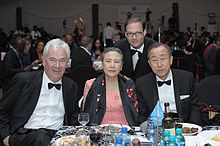Schools for Africa
The project Schools for Africa (English: Schools for Africa ) was from 2004 UNICEF , the Nelson Mandela Foundation established and the "Hamburg Society for the Promotion of Democracy and International Law". The aim of the initiative is to ensure that as many children as possible in Africa receive an education. After 2015, no more activities were detectable.
history
When the project was founded by UNICEF - the United Nations Children's Fund -, the Nelson Mandela Foundation and the “Hamburg Society for the Promotion of Democracy and International Law” on December 6, 2004 in South Africa , the former South African President Nelson Mandela said: “Education is access to freedom, democracy and development ”.
The “Hamburg Society for the Promotion of Democracy and International Law” was founded by the German shipowner Peter Krämer (1950–2017) and later renamed the “Peter Krämer Foundation”. Support for schools and students from Germany has been carried out in Madagascar , Malawi , Niger , Rwanda and South Africa since 2005 . A total of 155,000 German citizens and 3,000 companies in Germany donated to the project by 2009. The money was used to build or repair 680 schools, and 740 schools received water connections or improved latrines . 1.3 million children received new classrooms or new school supplies. Together with the training of 80,000 teachers, the teaching situation for 3.6 million children in Africa has improved (as of the end of 2009). Peter Krämer contributed significantly to the financing with his own donations of millions. The project is described on its website as "the most important and most successful private initiative in the education sector worldwide".

One goal of the international project was to help more than 40 million children by 2009. UNICEF ushered in the second phase of the project with an event in Berlin at the end of November 2009. Also present were UNICEF patron Eva Luise Köhler , Oliver Bierhoff , the manager of the German national soccer team and UNICEF ambassador, Peter Krämer, the chairman of UNICEF Germany, Jürgen Heraeus , and UNICEF godmother Eva Padberg . From the beginning of 2010, “Schools for Africa” was expanded to five other countries: Ethiopia, Burkina Faso, Mali, Madagascar and Niger.
In 2012, Krämer opened the thousandth school financed by the project in Maputo .
According to information on the English language website, donations of over $ 200 million had supported more than 30 million students by 2015.
UNICEF planned to end the project in 2015.
Structure and goals
Many students in Africa do not receive adequate schooling. The causes include poverty, poor infrastructure, discrimination against girls and diseases such as AIDS . Attending school is associated with costs that often cannot be raised. However, a good school education is seen as the key to escaping poverty.
UNICEF used the donations from the “Schools for Africa” campaign in 13 program countries: Angola , Ethiopia , Burkina Faso , Guinea-Bissau , Madagascar , Malawi , Mali , Mozambique , Niger , Rwanda , Sierra Leone , Zimbabwe and South Africa . There UNICEF helped to restore dilapidated classrooms or build new rooms. It ensured an improved drinking water supply and simple latrines in the schools. Pupils and teachers were provided with books, exercise books and teaching material, and UNICEF provided benches, tables and blackboards for the classrooms. At the same time, UNICEF trained teachers so that they can make their lessons more child-friendly. School principals received help to organize school operations well. In many schools, UNICEF sponsored regular examinations and vaccinations to improve the children's health. In order to strengthen the solidarity and willingness to help among the students, UNICEF supported student clubs where the children could meet in the afternoons.
Donors also included the IKEA Foundation and Gucci .
Criticism related to Schools for Africa
In 2010, the collaboration between UNICEF and the confectionery manufacturer Cadbury Canada was criticized by medical professionals as sugarwashing . Cadbury had 500,000 dollars to Schools for Africa donated and then advertised with the UNICEF logo on its confectionery packaging.
Web links
- Schools for Africa (English)
- Schools for Africa
Individual evidence
- ↑ a b Website of the Peter Krämer Foundation, accessed on September 24, 2017
- ↑ Oliver Bierhoff supports the “Schools for Africa” campaign. German Football Association 2009, accessed on September 24, 2017
- ↑ UNICEF press release of November 26, 2009 , accessed September 25, 2017
- ↑ Peter Krämer Foundation opens school. Hamburger Abendblatt from October 12, 2012, accessed on September 24, 2017
- ↑ Schools for Africa , accessed September 24, 2017
- ↑ a b Supporters. schoolsforafrica.com, accessed September 23, 2017
- ↑ Schools for Africa at betterplace.org, accessed on September 25, 2017
- ^ R. Collier: Critics say UNICEF-Cadbury partnership is more sugarwashing. In: CMAJ: Canadian Medical Association journal = journal de l'Association medicale canadienne. Volume 182, number 18, December 2010, pp. E813-E814, doi : 10.1503 / cmaj.109-3720 , PMID 21059780 , PMC 3001519 (free full text).
